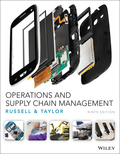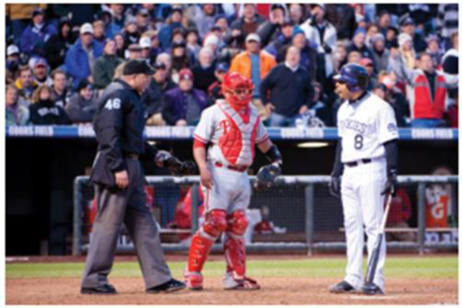
Concept explainers
It used to be that major league baseball (MLB) umpires were scheduled on an Excel spreadsheet. The task took several weeks and had to be revised often. Now they use a scheduling system developed by researchers at the University of Miami, Carnegie Mellon, and Michigan State University. A variant of the classic Traveling Salesman problem, umpires, as shown in the photo, are assigned to crews that must visit all ballparks at least once during the year. Of course, there are many more constraints.

Perspectives/Jeff Smith/Shutterstock
MLB teams play 2430 games in a two- to four-game series during a six-month season. Each game requires a crew of four umpires. There are currently 70 umpires on MLB staff, and 22 AAA umpires who may be called up as needed to fill in for games. A typical umpire will handle 142 games a year. Unlike football referees, umpires are full-time employees of MLB. Umpires are normally assigned to crews, but the content of these crews can change during the year. Constraints to umpire crew scheduling include mandated vacations, overexposure to individual teams, prohibition to refereeing at home, and minimizing coast-to-coast travel. Examples of MLB rules used to enforce these constraints are:
- Crews should travel to all 30 ballparks at least once during a season.
- Crews should not umpire the same team’s series of games more than once every 18 days.
- Crews must not travel from the West Coast to the East Coast without an intermediate day off.
- Crews must not umpire consecutive series more than 1700 miles apart without an intermediate day off.
- Crews must not travel more than 300 miles preceding a series whose first game is a day game.
- Crews should not work more than 21 days without a day off.
- Crews should see each team at home and on the road at least once.
- Crews should have balanced schedules (i.e., travel approximately the same number of miles, umpire the same number of games, and have the same number of days off).
Real-life scheduling problems, like umpire scheduling, can be quite complex. The general solution approach is similar to the assignment method of linear programming described in this chapter. There is an objective function of minimizing distance traveled subject to a number of constraints, as listed earlier. The variables are (0,1) meaning an umpire is either assigned to a game slot (i.e., 1), or not (i.e., 0), and the game slots are numerous (2430 × 4 = 9720). While this can be solved as an integer linear programming (LP) problem, the length of time to do so and the inability to relax constraints make it difficult to find a feasible solution.
Academics use heuristics, or rules of thumb, to solve these types of problems. Heuristics do not necessarily satisfy all constraints and do not guarantee an optimal solution, but they can give satisficing or “good enough” solutions. The heuristics are evaluated against performance metrics, previous solutions, and “optimal” solutions (from mathematical programming such as LP). The heuristics are usually improved on with use until users accept them. Many are then coded into software and sold as scheduling systems for particular applications.
Search the Internet for scheduling software specific to sports teams or referees. What functionality does the software promise?
Case summary:
The league of baseball has a complex scheduling system need to do umpire management. A six month season requires use of a system developed by researchers to manage the umpires, manage crew change, vacation management, minimizing travel and many more constraints. This complex situation cannot be handled through linear programming because it can be a time consuming approach because of its inflexibility due to these many constraints. A heuristic model or thumb of rule system helps find a good solution easily which might not be the best but is a practical and faster approach.
To determine:
Research on the web about sport management software that helps to schedule sports teams.
Explanation of Solution
Sports management software:
These days there are multiple softwares available that are specifically designed for sports industry that will help the managing organization bodies to satisfy their scheduling needs.
The software “MCS” is an ideal solution to manage the team activity scheduling, providing efficient communication tool to coordinate the members.
LR software solution also analysis the scheduling process and provides statistical modelling to help future planning. The payment processing, leave and vacation management, travel itinerary solutions are also provided by this software.
Company “A” is an umpire assigning software that helps to schedule umpires by handling multiple constraints, include communication to them as well as their payroll processing.
These solutions provide faster and effective management and are able to handle multiple variables that are specific to the sports industry.
There are dedicated softwares available in the sports industry that helps to make the process of scheduling easier and optimal. Some of the solution providers are discussed above.
Want to see more full solutions like this?
Chapter 17 Solutions
Operations and Supply Chain Management 9th edition
Additional Business Textbook Solutions
Principles of Economics (MindTap Course List)
Horngren's Accounting (12th Edition)
Operations Management
Business Essentials (12th Edition) (What's New in Intro to Business)
Horngren's Financial & Managerial Accounting, The Financial Chapters (Book & Access Card)
FUNDAMENTALS OF CORPORATE FINANCE
- Perform a External analysis using PESTEL and Porters five force analysis on the "ATB: Digital disruption in the parking meter industry" casearrow_forwardThere was a most recent poll for which 571 adults that flew in the past year had info collected. This info was their number 1 complaints about flying. A - small cramped seat - 45 complaints B - cost - 18 complaints C - fear or dislike - 81 complaints D - security - 123 complaints E - Poor service - 12 complaints F - Conntected flight issue - 8 complaints G - overcrowded - 41 complaints H - Late and wait - 81 complaints I - Food - 5 complaints J - Lost/missing luggage - 5 complaints K - Other - 51 complaints What percentage of those surveyed found nothing they didnt dislike?arrow_forwardCan you help me with this, and explain what a product by value analysis is? Thanks in advancearrow_forward
- Operations Management Questionarrow_forwardcan you explain and breakdown the "ATB: digital disruption in the parking meter industry" case in detail outlining the key issuesarrow_forwardAt Quick Car Wash, the wash process is advertised to take less than 6 minutes. Consequently, management has set a target average of 330 seconds for the wash process. Suppose the average range for a sample of 7 cars is 10 seconds. Use the accompanying table to establish control limits for sample means and ranges for the car wash process. Click the icon to view the table of factors for calculating three-sigma limits for the x-chart and R-chart. The UCLR equals seconds and the LCLR equals seconds. (Enter your responses rounded to two decimal places.)arrow_forward
- If Jeremy who is the VP for the operations, proceeds with their existing prototype (which is option a), the firm can then expect sales to be 120,000 units at $550 each. And with a probability of 0.52 and a 0.48 probability of 65,000 at $550. we However, he uses his value analysis team (option b), the firm expects sales of 75,000 units at $770, with a probability of 0.78 and a 0.22 probability of 65,000 units at $770. Value engineering, at a cost of $100,000, is only used in option b. Which option for this has the highest expected monetary value (EMV)? The EMV for option a is $? The EMV for option b is $? Which has the highest expected monetary value. A or B?arrow_forwardPart 1 of 2 Jim's Outfitters, Inc., makes custom western shirts. The shirts could be flawed in various ways, including flaws in the weave or color of the fabric, loose buttons or decorations, wrong dimensions, and uneven stitches. Jim randomly examined 10 shirts, with the following results shown to the right. Shirt Defects 1 7 2 1 4 13 3 10 2 8 5 9 10 8 7 a. Assuming that 10 observations are adequate for these purposes, determine the three-sigma control limits for defects per shirt. The UCLC equals and the LCL equals (Enter your responses rounded to two decimal places. If your answer for LCL is negative, enter this value as 0.)arrow_forwardManagement at Webster Chemical Company is concerned as to whether caulking tubes are being properly capped. If a significant proportion of the tubes are not being sealed, Webster is placing its customers in a messy situation. Tubes are packaged in large boxes of 144. Several boxes are inspected, and the following numbers of leaking tubes are found: Sample Tubes Sample Tubes Sample Tubes 1 7 8 7 15 7 2 7 9 8 16 9 3 6 10 7 17 3 4 4 11 1 18 7 5 8 12 8 19 7 6 7 2 9 13 14 1 20 6 7 Total 121 Calculate p-chart three-sigma control limits to assess whether the capping process is in statistical control. The UCLp equals and the LCLp equals (Enter your responses rounded to three decimal places. If your answer for LCLp is negative, enter this value as 0.)arrow_forward
- Aspen Plastics produces plastic bottles to customer order. The quality inspector randomly selects four bottles from the bottle machine and measures the outside diameter of the bottle neck, a critical quality dimension that determines whether the bottle cap will fit properly. The dimensions (in.) from the last six samples are Bottle Sample 1 2 3 4 1 0.624 0.586 0.602 0.591 2 0.613 0.599 0.578 0.618 3 0.606 0.585 0.587 0.623 4 0.581 0.623 0.571 0.610 5 0.609 0.610 0.623 0.617 6 0.605 0.573 0.570 0.602 Click the icon to view the table of factors for calculating three-sigma limits for the x-chart and R-chart. Suppose that the specification for the bottle neck diameter is 0.600 ± 0.050 in. and the population standard deviation is 0.014 in. a. What is the process capability index? The Cpk is (Enter your response rounded to two decimal places.)arrow_forwardHow would you handle the Apple 'batterygate' scandal as an operations manager? What quality measures would you take to fix the problem and prevent it from happening again? When would you implement these measures and communicate with the stakeholders?arrow_forwardPerosnal Thoughts about the articlearrow_forward
 Practical Management ScienceOperations ManagementISBN:9781337406659Author:WINSTON, Wayne L.Publisher:Cengage,
Practical Management ScienceOperations ManagementISBN:9781337406659Author:WINSTON, Wayne L.Publisher:Cengage, Purchasing and Supply Chain ManagementOperations ManagementISBN:9781285869681Author:Robert M. Monczka, Robert B. Handfield, Larry C. Giunipero, James L. PattersonPublisher:Cengage Learning
Purchasing and Supply Chain ManagementOperations ManagementISBN:9781285869681Author:Robert M. Monczka, Robert B. Handfield, Larry C. Giunipero, James L. PattersonPublisher:Cengage Learning


